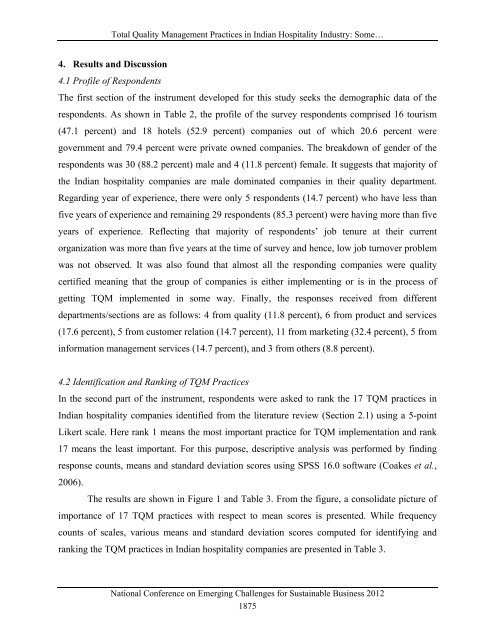Total Quality Management Practices in Indian Hospitality Industry ...
Total Quality Management Practices in Indian Hospitality Industry ...
Total Quality Management Practices in Indian Hospitality Industry ...
You also want an ePaper? Increase the reach of your titles
YUMPU automatically turns print PDFs into web optimized ePapers that Google loves.
<strong>Total</strong> <strong>Quality</strong> <strong>Management</strong> <strong>Practices</strong> <strong>in</strong> <strong>Indian</strong> <strong>Hospitality</strong> <strong>Industry</strong>: Some…<br />
4. Results and Discussion<br />
4.1 Profile of Respondents<br />
The first section of the <strong>in</strong>strument developed for this study seeks the demographic data of the<br />
respondents. As shown <strong>in</strong> Table 2, the profile of the survey respondents comprised 16 tourism<br />
(47.1 percent) and 18 hotels (52.9 percent) companies out of which 20.6 percent were<br />
government and 79.4 percent were private owned companies. The breakdown of gender of the<br />
respondents was 30 (88.2 percent) male and 4 (11.8 percent) female. It suggests that majority of<br />
the <strong>Indian</strong> hospitality companies are male dom<strong>in</strong>ated companies <strong>in</strong> their quality department.<br />
Regard<strong>in</strong>g year of experience, there were only 5 respondents (14.7 percent) who have less than<br />
five years of experience and rema<strong>in</strong><strong>in</strong>g 29 respondents (85.3 percent) were hav<strong>in</strong>g more than five<br />
years of experience. Reflect<strong>in</strong>g that majority of respondents’ job tenure at their current<br />
organization was more than five years at the time of survey and hence, low job turnover problem<br />
was not observed. It was also found that almost all the respond<strong>in</strong>g companies were quality<br />
certified mean<strong>in</strong>g that the group of companies is either implement<strong>in</strong>g or is <strong>in</strong> the process of<br />
gett<strong>in</strong>g TQM implemented <strong>in</strong> some way. F<strong>in</strong>ally, the responses received from different<br />
departments/sections are as follows: 4 from quality (11.8 percent), 6 from product and services<br />
(17.6 percent), 5 from customer relation (14.7 percent), 11 from market<strong>in</strong>g (32.4 percent), 5 from<br />
<strong>in</strong>formation management services (14.7 percent), and 3 from others (8.8 percent).<br />
4.2 Identification and Rank<strong>in</strong>g of TQM <strong>Practices</strong><br />
In the second part of the <strong>in</strong>strument, respondents were asked to rank the 17 TQM practices <strong>in</strong><br />
<strong>Indian</strong> hospitality companies identified from the literature review (Section 2.1) us<strong>in</strong>g a 5-po<strong>in</strong>t<br />
Likert scale. Here rank 1 means the most important practice for TQM implementation and rank<br />
17 means the least important. For this purpose, descriptive analysis was performed by f<strong>in</strong>d<strong>in</strong>g<br />
response counts, means and standard deviation scores us<strong>in</strong>g SPSS 16.0 software (Coakes et al.,<br />
2006).<br />
The results are shown <strong>in</strong> Figure 1 and Table 3. From the figure, a consolidate picture of<br />
importance of 17 TQM practices with respect to mean scores is presented. While frequency<br />
counts of scales, various means and standard deviation scores computed for identify<strong>in</strong>g and<br />
rank<strong>in</strong>g the TQM practices <strong>in</strong> <strong>Indian</strong> hospitality companies are presented <strong>in</strong> Table 3.<br />
National Conference on Emerg<strong>in</strong>g Challenges for Susta<strong>in</strong>able Bus<strong>in</strong>ess 2012<br />
1875


